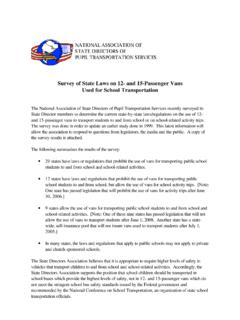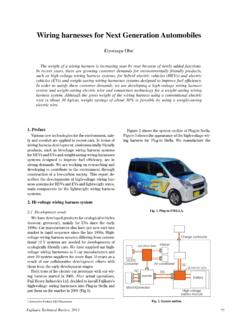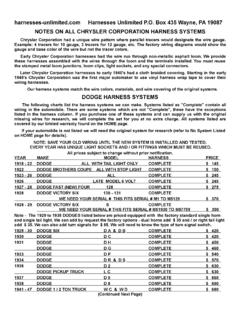Transcription of Safety Harnesses and School Buses - NASDPTS
1 Safety Harnesses and School Buses During the 2001 Annual Conference of the National Association of State Directors of Pupil Transportation Services, discussions were held with representatives of the National Highway Traffic Safety Administration (NHTSA) on whether a Safety harness (which is also known as a restraining harness, vest, or positioning vest/harness) can comply with all applicable federal regulations and can be safely used on School Buses . As a result of those discussions, the State Directors Association is providing the following information to its members in an effort to clarify the issues and provide guidance on the safe transportation of children who weigh 50 pounds or less in School Buses .
2 The Issue: Section of Federal Motor Vehicle Safety Standard (FMVSS) No. 213, Child Restraint Systems states: Except for components designed to attach to a child restraint anchorage system, each add-on child restraint system shall not have any means designed for attaching the system to a vehicle seat cushion or vehicle seat back and any component (except belts) that is designed to be inserted between the vehicle seat cushion and vehicle seat back. Thus, any Safety harness ( restraining harness, vest, positioning vest/harness) that is secured to a School bus bench seat back solely by means of a webbing wrap ( cam-rap, adjusting strap, cam-harness) would not comply with this aspect of FMVSS No.
3 213. As explained in an August 2001 Letter of Interpretation, NHTSA adopted the prohibition against attaching child restraints to vehicle seat backs because the agency was concerned that a vehicle seat back would not be able to withstand the additional load on it from an attached child seat in a crash. The Letter of Interpretation was written in response to a request from a Safety harness manufacturer that asked whether the device was subject to the requirements of FMVSS No. 213. Crash tests performed by NHTSA using pre- School age size dummies in School bus seats show children that weigh 40 pounds or less are safest when transported in child Safety restraint systems which meet FMVSS No.
4 213, and are correctly attached to the seat through the use of the available belt and/or child seat anchorage systems in the vehicle. While FMVSS No. 213 applies to child Safety restraint systems that are designed for children who weigh 50 pounds or less, the NHTSA crash testing has only been done on test dummies up to 40 pounds. Page 2. Background Data / Facts: A child restraint system , as defined in FMVSS No. 213, means any device except Type I or Type II seat belts, designed for use in a motor vehicle or aircraft to restrain, seat, or position children who weigh 50 pounds or less. A child Safety restraint system, as defined in NHTSA s Guideline for the Safe Transportation of Pre- School age Children in School Buses , means any device (except a passenger system lap seat belt or lap/shoulder seat belt), designed for use in a motor vehicle to restrain, seat, or position a child who weighs less than 50 pounds.
5 A Safety harness ( restraining harness, vest, positioning vest/harness) designed for a passenger who weights 50 pounds or less is considered a child restraint system by NHTSA. A Safety harness that incorporates a webbing wrap ( cam-rap, adjusting strap, cam-harness) would not comply with Section of FMVSS No. 213. A Safety harness that is designed to be secured to the School bus seat by means of lap belts attached to the loading bar of a lap belt-ready seat and a top tether may comply with FMVSS No. 213. If a student s Individual Education Plan calls for or requires the use of a restraint system, such as a restraining harness, vest, or positioning vest/harness, that does not comply with all of the requirements of FMVSS No.
6 213, a conflict exists. The requirements of an Individual Education Plan do not supersede or negate the requirements of FMVSS No. 213. A child Safety restraint system, which includes Safety Harnesses , is best secured when attached to a School bus seat meeting FMVSS No. 209, Seat Belt Assemblies, and FMVSS No. 210, Seat Belt Assembly Anchorages, or FMVSS No. 225, Tether Anchorages and Child Restraint Anchorage Systems. Cost: The amount of money involved is the actual difference in price between a child Safety seat and a Safety harness. A lap belt-ready seat is needed to properly secure any child Safety restraint system, including a Safety harness.
7 Therefore, the cost of the lap belt-ready seat is not a factor. Page 3. Guidance: Child Safety restraint systems that meet the requirements of FMVSS No. 213 should be the first choice when transporting children who weigh 50 pounds or less in any motor vehicle, including a School bus. If a Safety harness ( restraining harness, vest, positioning vest/harness) is used, it should be certified by the manufacturer as meeting all of the FMVSS No. 213 requirements, including those in Section Any Safety harness is best secured to the School bus seat with a lap belt and top tether. The top tether should be secured to the loading bar [the metal structure where the lap belts are bolted to the seat frame] of a lap belt-ready seat frame.
8 [See picture of lap belt-ready seat below.] This can be accomplished by either directly attaching the tether to the loading bar or by attaching the tether to the lap belts on the seat, since those lap belts are attached to the loading bar. The top tether should be secured to the loading bar on the seat behind the seat where the child is seated, not on the same seat that the child occupies. The top tether is not to be wrapped around the seat back cushion. [See pictures below. The top picture shows the tether hooked to a lap belt on a lap-belt ready seat. The bottom picture has the seat bottom cushion moved forward in order to show the tether bolted directly to the loading bar.]
9 ] The seat behind the passenger restrained by the Safety harness should remain unoccupied. Page 4. Page 5. Additional Information: NHTSA realizes that its August 2001 Letter of Interpretation conflicts with information that appears it its publication, Proper Use of Child Safety Restraint Systems in School Buses . That publication received wide distribution and appears on NHTSA s web site -- That publication was prepared based on input from numerous sources, including the pupil transportation industry. Currently, the publication states: Safety Vest Can be used with a lap belt and a strap (cam-wrap) that wraps around the back of the seat, to which the shoulder harness straps are hooked.
10 The Safety vest can also be used if no lap belt is present, in which case the vest is attached to the cam-wrap at the hips and shoulders Use according to manufacturer s instructions Vest must be sized to child Must be secured at shoulder and hips NHTSA may delete certain information about Safety vests from that publication and will provide clarification on how such devices can be used safely. The information in the first bullet may be changed to reflect the fact that a Safety vest incorporating a cam-wrap does not comply with FMVSS No. 213. In addition, NHTSA intends to review available information about real-world experiences (crashes and sudden driving maneuvers) with Safety Harnesses that are attached to the School bus seat solely by a webbing wrap ( cam-wrap, adjusting strap, cam-harness).














